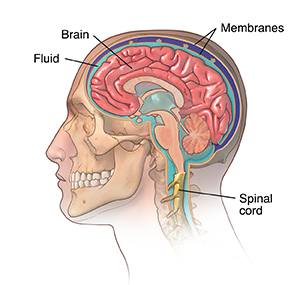Meningitis
What is meningitis?
Meningitis is a disease caused by an inflammation of the meninges. These are the membranes that surround the brain and spinal cord. The inflammation is usually caused by infection of the fluid surrounding the brain and spinal cord.

What causes meningitis?
There are several types of meningitis with different causes:
| Cause | Details |
|
Viral (caused by a virus) |
|
|
Bacterial (caused by a bacterium) |
|
| Fungal meningitis (caused by a fungus) |
|
| Aseptic meningitis |
|
| Carcinomatous meningitis |
|
What are the symptoms of meningitis?
These are the most common symptoms of meningitis:
- Fever
- Headache
- Nausea and vomiting
- Stiff neck
- Sensitivity to bright light
- Confusion
- Joint aches or pains
- Drowsiness
- Seizures
Symptoms for children may include:
- Fever
- High-pitched cry
- Pale, blotchy skin color
- Not wanting to eat
- Vomiting
- Fretful and fussy
- Arching back
- Difficult to wake
These symptoms may not occur all at once. And not everyone who gets meningitis will have all of these symptoms. The symptoms of meningitis may look like other health problems. Always see your healthcare provider for a diagnosis.
How is meningitis diagnosed?
Along with a health history and physical exam, your healthcare provider may do one or more of the following tests:
- Spinal tap (lumbar puncture). The healthcare provider puts a needle into the lower back and into the spinal canal. This is the area around the spinal cord. They measure the pressure in the spinal canal and brain. The provider may remove a small amount of cerebral spinal fluid (CSF) to test it for infection or other problems. CSF is the fluid that bathes the brain and spinal cord.
- Blood testing. Blood is collected and tested for infection.
- CT scan. This procedure uses X-rays and a computer to make images of the body. A CT scan shows detailed images of any part of the body. This includes the bones, muscles, fat, and organs. CT scans are more detailed than general X-rays.
- MRI. This procedure uses a magnet to create very detailed images of the brain and spine. MRI uses no radiation but may take longer than a CT scan.
How is meningitis treated?
Treatment may include:
- Bacterial meningitis. IV (intravenous) antibiotics are used to treat bacterial meningitis. The earlier the treatment is started, the better the outcome. Steroids can help in treating bacterial meningitis in babies and children. But this treatment is used less often in adults. Dexamethasone is a type of steroid. It may be given in certain cases of bacterial meningitis. It lowers the inflammatory response caused by the bacteria.
- Viral meningitis. Treatment for viral meningitis is usually aimed at easing symptoms. Except for the herpes simplex virus, there are no specific medicines to treat the viruses that cause meningitis. Sometimes antiviral medicines are used to treat some other specific types of viruses.
While you are recovering from meningitis, your healthcare provider may advise other treatments to help you get better faster and ease symptoms. These may include:
- Bed rest in a dimly lit room
- Medicines to reduce fever and headache. Don't take aspirin.
You may need extra oxygen or a breathing machine (ventilator) if you become very ill and have trouble breathing.
Can meningitis be prevented?
Several vaccines can prevent types of bacterial meningitis. These vaccines are recommended for babies and children. Two doses between ages 11 and 18 are also recommended.
In certain cases, your healthcare provider may advise one of the meningitis vaccines. You may need a meningitis vaccine if you have:
- Chronic lung conditions, such as emphysema or chronic obstructive pulmonary disease
- Heart disease
- Diabetes
- Chronic kidney failure
- Decreased immunity status
- Certain blood disorders
- Damaged or removed spleen
You may also need one if you travel to countries where meningitis is widespread. If you have questions about prevention, see your healthcare provider.
Wearing insect repellant and long pants and sleeves may also reduce the risk of certain viruses spread by mosquitoes and other insects.
Key points about meningitis
- Meningitis is a disease caused by an inflammation of the meninges. These are the membranes that surround the brain and spinal cord.
- It's usually caused by a virus. But it can be caused by bacteria and fungi.
- Sometimes meningitis can be from noninfectious causes, such as autoimmune disorders or medicines.
- Treatment for meningitis depends on the cause of the disease.
- Vaccines can prevent or lower your chance of getting meningitis.
Next steps
Tips to help you get the most from a visit to your healthcare provider:
- Know the reason for your visit and what you want to happen.
- Before your visit, write down questions you want answered.
- Bring someone with you to help you ask questions and remember what your provider tells you.
- At the visit, write down the name of a new diagnosis and any new medicines, treatments, or tests. Also write down any new instructions your provider gives you.
- Know why a new medicine or treatment is prescribed and how it will help you. Also know what the side effects are.
- Ask if your condition can be treated in other ways.
- Know why a test or procedure is recommended and what the results could mean.
- Know what to expect if you do not take the medicine or have the test or procedure.
- If you have a follow-up appointment, write down the date, time, and purpose for that visit.
- Know how you can contact your healthcare provider if you have questions, especially after office hours or on weekends.
Connect with providers for illnesses like flus, UTIs and rashes (ages 3+) or chronic conditions like asthma, weight management and diabetes (ages 18+).
Cedars-Sinai has a range of comprehensive treatment options.


